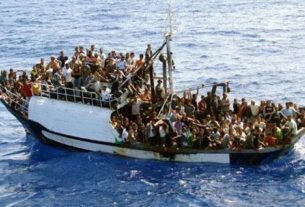Russia and Ukraine traded deadly aerial attacks on civilian centres in the past week of the war, but Ukraine also scored hits on military and economic infrastructure deep in the Russian heartland, extending its reach to St Petersburg for the first time.
Ukrainian military intelligence said it had struck an unspecified military target in St Petersburg on Thursday, using drones launched from Ukrainian soil.
Ukrainian strategic industries minister Oleksandr Kamyshin confirmed the attack, telling the World Economic Forum in Davos that the attack was carried out by a Ukrainian-built drone that had travelled 1,250km (780 miles) from Ukrainian soil.
Russia’s defence ministry said three drones had been launched and it had downed all three over the Gulf of Finland that day, one near an oil terminal.
On Sunday, Ukraine attacked again in several locations, and this time, the evidence of its success was clear.
Russian gas producer Novatek said it was suspending operations at a plant and loading terminal in the port of Ust-Luga near St Petersburg, following a fire, which Ukrainian media credited to due to a drone attack, citing Security Service (SBU) sources.
Novatek said it had resumed loading on Wednesday, but plant operations could take weeks or months to return to normal, analysts said. This meant the company would lose money, exporting low-value gas condensate rather than processed naphtha, jet fuel and gasoil.
Kremlin spokesman Dmitry Peskov said aerial defences were being strengthened following the attack.
Ukraine also claimed to have attacked the Shcheglovsky Val plant in Tula, 150km (93 miles) south of Moscow, which reportedly manufactures the Pantsir-S and Pantsir-S1 air defence systems.
Geolocated footage also showed smoke rising from the city of Smolensk, near the Russian border with Belarus, suggesting a possible third attack that day.
Ukraine has been developing its own long-range aerial and surface drones at least since the middle of last year, when it attacked several military targets in Crimea and the Black Sea.
Unlike donated Western weapons, they do not carry restrictions about their use on Russian soil.
Ukrainian National Defence and Security Council Secretary Oleksiy Danilov claimed that Ukraine was among the top three drone manufacturers in the world.
Ukraine is suspected of being responsible for the shelling of Donetsk city in its occupied east, which killed at least 27 people on Sunday, although it did not claim the attack.
Russia has routinely targeted Ukrainian cities, and did so again with deadly results. Kharkiv bore the heaviest toll.
Russian missiles killed 18 people and injured an estimated 130 in various cities on Tuesday, but eight of the dead were in Kharkiv, said its mayor, which suffered three waves of attacks. At least 100 high-rise blocks had been hit in the city.
Ukraine defended its airspace from the repeated attacks.
It shot down 19 out of 20 Shahed drones last Wednesday, 22 out of 33 drones on Thursday, and four out of seven drones on Saturday.
In each case, Russia also used a small number of missiles, as it has been doing for months, copying a Ukrainian tactic designed to overload air defence systems.
A Pentagon official said these were probing attacks as Russia looked for weaknesses in defences.
“They’ve not succeeded so far. Ukrainians have a lot of experience over the last few years on how to cope with these kinds of Russian assaults,” Celeste Wallander, an assistant secretary of defense, told reporters.
What made Tuesday’s attack different was that Russia used no drones. It launched 44 missiles of various types, half of which Ukraine intercepted, mostly over Kyiv.
No end in sight
Ukraine’s Western allies continued to pledge weapons and ammunition, forecasting a third year of war, as defiant Russian rhetoric left little hope of negotiations any time soon.
“The existence of Ukraine is mortally dangerous for Ukrainians,” wrote Dmitry Medvedev, the deputy head of Russia’s powerful Security Council, on the Telegram messaging app.
“The presence of an independent state on historical Russian territories will now be a constant reason for the resumption of hostilities,” he said, elucidating an irredentist policy towards all of Ukraine.
“There is a 100 percent probability of a new conflict,” Medvedev said, even if Ukraine entered the EU and NATO. “This could happen in ten or fifty years.”
Some in Europe took Russia at its word.
“We hear threats from the Kremlin almost every day … so we have to take into account that Vladimir Putin might even attack a NATO country one day,” German Defence Minister Boris Pistorius told Tagesspiegel.
“Our experts expect a period of five to eight years in which this could be possible,” Pistorius said.
It was the latest in a series of ominous warnings. NATO’s military committee chief called for a “warfighting transformation” of NATO two weeks ago.
And the commander-in-chief of Sweden, which came a step closer to NATO membership when Turkey’s parliament ratified its bid on Tuesday, last week told Swedes to prepare for war.
Even Russian Foreign Minister Sergey Lavrov, who as recently as last September was saying Russia was ready for talks, said Russia “will achieve the goals of its ‘special military operation’ consistently and persistently.”
Looking for ammunition
Accordingly, Western governments have been stepping up ammunition production. Varying estimates give Russia an advantage of between 5:1 and 10:1 in artillery shells.
There is concern that disparity could harm Ukraine’s stout defence. During the past week, for example, Ukraine has retreated some hundreds of yards in Kharkiv, where Russia has been assaulting the front lines relentlessly.
European internal market commissioner Thierry Breton said on Saturday that EU defence industries would be capable of producing a million artillery shells a year by April, up to 1.4 million by the end of the year and more next year.
Defence industries have complained that they cannot increase production unless governments provide long-term contracts, and NATO on Tuesday made up for some of this shortfall with a $1.2bn contract to two manufacturers for 200,000 rounds of artillery ammunition.
The NATO Support and Procurement Agency (NSPA) struck the deal on behalf of allies who will either pass on the shells to Ukraine or use them to stock up their own depleted inventories.
Poland became the latest EU member to sign a bilateral 2024 defence agreement with Ukraine on Monday, following Germany, Estonia and Latvia. Germany announced it would provide six Sea King helicopters to monitor coastal waters.
Ukrainian president Volodymyr Zelenskyy said he expected a number of “strong” defence packages for Ukraine to be signed “on specific dates” this month and next
These bilateral agreements have ignored a Hungarian veto to a four-year, 50-billion-euro EU financial support plan for Ukraine, and a 20-billion-euro defence support plan this year that would reimburse members for some of their donations.
European lawmakers also took a step towards depriving Hungary of its voting rights in the EU last Thursday [January 18] when they asked the European Council of government leaders to look into whether Hungary had “committed serious and persistent breaches of EU values”. Suspending a member’s vote is possible under Article 7 of the Treaty on European Union, but it has never been invoked before.__aljazeera.com





